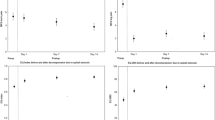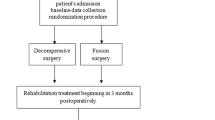Abstract
Leg pain/numbness and gait disturbance, two major symptoms in the lower extremities of lumbar spinal stenosis (LSS), are generally expected to be alleviated by decompression surgery. However, the paucity of information available to patients before surgery about specific predictors has resulted in some of them being dissatisfied with the surgical outcome when the major symptoms remain after the procedure. This prospective, observational study sought to identify the predictors of the outcome of a decompression surgery: modified fenestration with restorative spinoplasty. Of 109 consecutive LSS patients who underwent the decompression surgery, 89 (56 males and 33 females) completed the 2 year follow-up. Both leg pain/numbness and gait disturbance determined by the Japanese Orthopedic Association scoring system were significantly improved at 2 years after surgery compared to those preoperative, regardless of potential predictors including gender, preoperative presence of resting numbness in the leg, drop foot, cauda equina syndrome, degenerative spinal deformity or myelographic filling defect, or the number of decompressed levels. However, 27 (30.3%) and 13 (14.6%) patients showed residual leg pain/numbness and gait disturbance, respectively. Among the variables examined, the preoperative resting numbness was associated with residual leg pain/numbness and gait disturbance, and the preoperative drop foot was associated with residual gait disturbance, which was confirmed by logistic regression analysis after adjustment for age and gender. This is the first study to identify specific predictors for these two remaining major symptoms of LSS after decompression surgery, and consideration could be given to including this in the informed consent.
Similar content being viewed by others
References
Aono H, Iwasaki M, Ohwada T et al (2007) Surgical outcome of drop foot caused by degenerative lumbar diseases. Spine 32:E262–E266
Babb A, Carlson WO (2006) Spinal stenosis. S D Med 59(3):103–105
Berthelot JM, Bertrand VA, Rodet D et al (1997) Lumbar spinal stenosis: a review. Rev Rheum Engl Ed 64:315–325
Bolender NF, Schonstrom NSR, Spengler DM (1985) Role of computed tomography and myelography in the diagnosis of central spinal stenosis. J Bone Joint Surg 67A:240–246
Fujiwara A, Kobayashi N, Saiki K et al (2003) Association of the Japanese Orthopaedic Association score with the oswestry disability index, roland–morris disability questionnare, and short-Form 36. Spine 28:1601–1607
Goh KJ, Khalifa W, Anslow P et al (2004) The clinical syndrome associated with lumbar spinal stenosis. Eur Neurol 52:242–249
Gunzburg R, Keller TS, Szpalski M et al (2003) Clinical and psychofunctional measures of conservative decompression surgery for lumbar spinal stenosis: a prospective cohort study. Eur Spine J 12:197–204
Katz J, Stucki G, Lipson S et al (1999) Predictors of surgical outcome in degenerative lumbar spinal stenosis. Spine 24:2229–2233
Katz JN, Lipson SJ, Brick GW et al (1995) Clinical correlates of patient satisfaction after laminectomy for degenerative lumbar spinal stenosis. Spine 20:1155–1160
Matsudaira K, Yamazaki T, Seichi A et al (2005) Spinal stenosis in grade I degenerative lumbar spondylolisthesis: a comparative study of outcomes following laminoplasty and laminectomy with instrumented spinal fusion. J Orthop Sci 10:270–276
Matsudaira K, Yamazaki T, Seichi A et al (2009) Modified fenestration with restorative spinoplasty for lumbar spinal stenosis. J Neurosurg Spine 10:587–594
Mazanec DJ, Podichetty VK, Hsia A (2002) Lumbar canal stenosis: start with nonsurgical therapy. Cleve Clin J Med 69:909–917
Olmarker K, Rydevik B (1992) Single- versus double-level nerve root compression: An experimental study on the porcine cauda equina with analysis of nerve impulse conduction properties. Clin Orthop 279:35–39
Porter RW, Ward D (1992) Cauda equina dysfunction. The significance of two-level pathology. Spine 17:9–15
Spratt KF, Keller TS, Szpalski M et al (2004) A predictive model for outcome after conservative decompression surgery for lumbar spinal stenosis. Eur Spine J 13:14–21
Taillard W (1954) Spondylolisthesis in children and adolescents. Acta Orthop Scand 24:115–144
Takahashi K, Miyazaki T, Takino T et al (1995) Epidural pressure measurements: relationship between epidural pressure and posture in patients with lumbar spinal stenosis. Spine 20:650–653
Takahashi K, Olmarker K, Holm S et al (1993) Double-level cauda equina compression: an experimental study with continuous monitoring of intraneural blood flow in the porcine cauda equina. J Orthop Res 11:104–109
Voorhies RM, Jiang X, Thomas N (2007) Predicting outcome in the surgical treatment of lumbar radiculopathy using the pain drawing score, McGill short form pain questionnaire, and risk factors including psychosocial issues and axial joint pain. Spine J 7:516–524
Weinstein JN, Tosteson TD, Lurie JD et al (2008) Surgical versus nonsurgical therapy for lumbar spinal stenosis. N Engl J Med 358:794–810
Author information
Authors and Affiliations
Corresponding author
Rights and permissions
About this article
Cite this article
Hara, N., Oka, H., Yamazaki, T. et al. Predictors of residual symptoms in lower extremities after decompression surgery on lumbar spinal stenosis. Eur Spine J 19, 1849–1854 (2010). https://doi.org/10.1007/s00586-010-1374-1
Received:
Revised:
Accepted:
Published:
Issue Date:
DOI: https://doi.org/10.1007/s00586-010-1374-1




